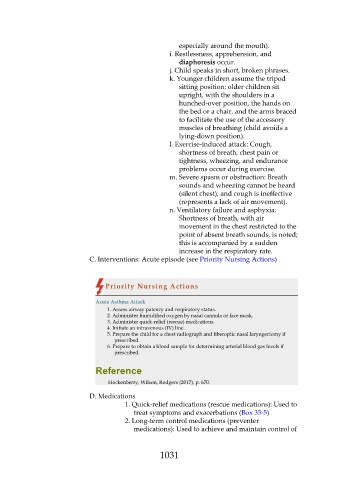Page 1031 - Saunders Comprehensive Review For NCLEX-RN
P. 1031
especially around the mouth).
i. Restlessness, apprehension, and
diaphoresis occur.
j. Child speaks in short, broken phrases.
k. Younger children assume the tripod
sitting position; older children sit
upright, with the shoulders in a
hunched-over position, the hands on
the bed or a chair, and the arms braced
to facilitate the use of the accessory
muscles of breathing (child avoids a
lying-down position).
l. Exercise-induced attack: Cough,
shortness of breath, chest pain or
tightness, wheezing, and endurance
problems occur during exercise.
m. Severe spasm or obstruction: Breath
sounds and wheezing cannot be heard
(silent chest), and cough is ineffective
(represents a lack of air movement).
n. Ventilatory failure and asphyxia:
Shortness of breath, with air
movement in the chest restricted to the
point of absent breath sounds, is noted;
this is accompanied by a sudden
increase in the respiratory rate.
C. Interventions: Acute episode (see Priority Nursing Actions)
Priority Nursing Actions
Acute Asthma Attack
1. Assess airway patency and respiratory status.
2. Administer humidified oxygen by nasal cannula or face mask.
3. Administer quick-relief (rescue) medications.
4. Initiate an intravenous (IV) line.
5. Prepare the child for a chest radiograph and fiberoptic nasal laryngectomy if
prescribed.
6. Prepare to obtain a blood sample for determining arterial blood gas levels if
prescribed.
Reference
Hockenberry, Wilson, Rodgers (2017), p. 670.
D. Medications
1. Quick-relief medications (rescue medications): Used to
treat symptoms and exacerbations (Box 35-5)
2. Long-term control medications (preventer
medications): Used to achieve and maintain control of
1031

